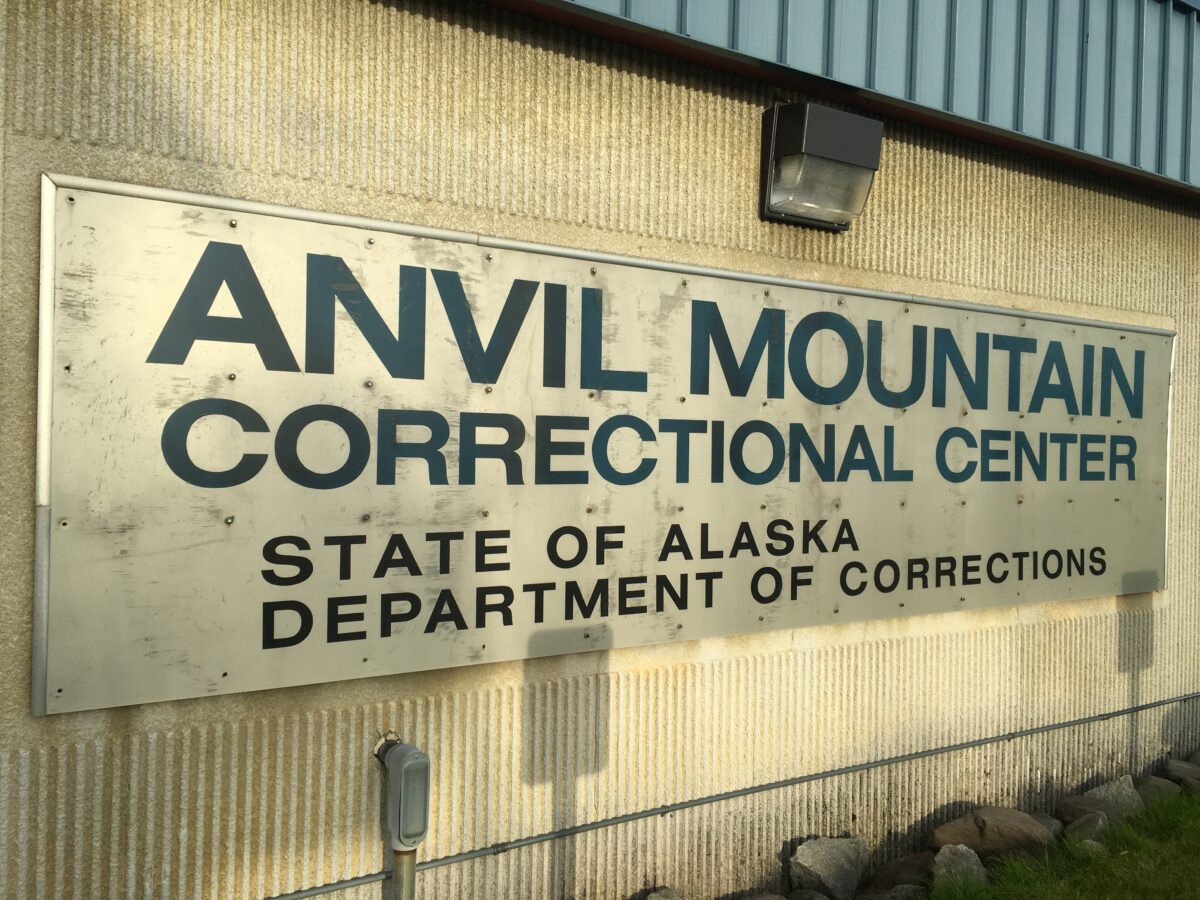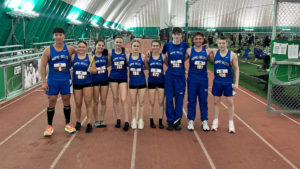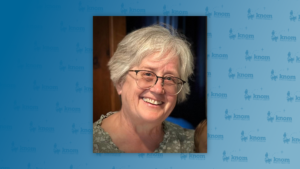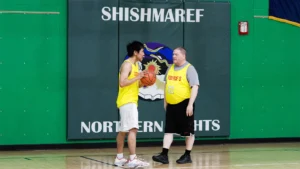The Alaska prison system has a problem with recidivism, or prisoner re-entry. About two-thirds of those released from prison in Alaska will become incarcerated again.
Now, facilities around the state are getting creative with programs to keep ex-offenders out of jail and in their communities. At the Anvil Mountain Correctional Center in Nome, inmates are getting the chance to connect with Alaska Native culture as part of the rehabilitative process.
“We all bring a unique skill or trait to this building, and everybody really tries hard to make this experience the best one we can.”
— Sandra Martinson, Superintendent AMCC
Back in August, I got an invitation to a potluck, a pretty common summer occasion in Alaska. But this one was special. It took place at the Anvil Mountain Correctional Center. It came as no surprise that the menu included fresh-caught salmon, but the salmon we would be enjoying was caught by some of the inmates themselves. The potluck was part of a new approach that AMCC has for reducing inmate recidivism. They’re trying to reform inmates by giving them the opportunity to connect to Alaska Native culture.
Sandra Martinson, the superintendent at AMCC, saw a way to build relationships between inmates and staff that was cost-effective and easy. Assign an officer to a few inmates, get them a fishing pole, a license, and a spot on the river to start catching. She explains:
“Men are out fishing, and they’ll bring it back, and the females cut the fish. They’ve had to do it in the fence, but they appreciate the opportunity to do it.”
The hope is that inmates and officers can build relationships and learn to trust each other. It also gives inmates the chance to work together on a project. Martinson hopes that these activities could lead to lasting relationships and lessons that inmates can continue once they leave the facility.
Former Commissioner Dean Williams saw the need for creativity and borrowed ideas and models from our Arctic neighbor, Norway. Norway has the lowest prisoner recidivism rate in the world. They practice what they call “rehabilitative justice,” a practice that seeks to teach the offender how to re-enter society rather than to punish them. Williams had the chance to go overseas and observe the Norwegian model and learn about the similarities between Alaska and where Norway used to be.
“One of the big mantras of Norway that I really took to is ‘punishment that works’… So, when you have someone that comes out of the prison system, you have someone who’s not more damaged, but what you’re doing behind the walls as far as job training, skill training — those things really matter. And those look different depending on which region you’re in.”
Anvil Mountain Correctional Center is an adult pre-trial and short-term sentence facility that serves Nome, Kotzebue, and the villages of the surrounding regions. Though the facility is overwhelmingly male, it does serve women, too.
Supervisor Martinson and education coordinator Christina Apostolou are working to break the cycle of recidivism. Martinson says that requires a fresh approach:
“I see the same people coming back again and again… I think recidivism around the state is 66%. Just as a whole, we need to find a new way of doing our business. And I feel like this is the new way. At least, it’s a new approach to the old ‘lock ‘em up and leave ‘em.’”
Most of the inmates at AMCC are Alaska Native. So, when recidivism remains high, it is Alaska Native families and villages who suffer the most.
The word I hear again and again is “relationship.” And as Williams points out, building relationships costs nothing in a situation where budget can be the biggest challenge.
“One of the things that you can do is you can be very purposeful about your interactions with prisoners and having your staff at all levels be very intentional about their relationships with prisoners… and how you start the relationship immediately when someone is incarcerated. You can change the dynamic behind the walls. So, it’s less of the us-vs.-them. You assign 3 or 4 inmates to one officer, and you have them get to know each other… we’ve already started to see some declines on inmate-on-inmate assaults.”
While Williams might have learned from Norway, the programs happening at AMCC are deeply western Alaskan.
Apostolou guides me through a classroom, where there are not only the standard GED books, but also musical instruments and walls lined with carved ivory soap sculptures. They don’t have real ivory but are making carvings out of soap to practice. Martinson stresses that this is a full community effort. “We had a gentleman in town donate his files. Free of charge!”, she tells me.
Like on the outside, the classes are taught by elders or men inside the facility who wanted to teach their skills. “We’re trying to treat people as a whole,” Apostolou says.
But one of the most exciting moments is when I have a chance to go back to a small, makeshift workshop. Thomas Hopson and Clifton Sun are building ulus that will be used to gut and fillet the fish that is caught. Female inmates at the facility will use them. Sun knew how to build ulus and is practicing the skill. Both Hopson and Sun had the opportunity to go fishing earlier in the summer. “I had fun fishing and working on stuff like this. We work on things like these on our own time. When we don’t have anything to do, we get locked up in here and work,” says Hopson. Sun adds, “We get out of the mud, get out of all the drama and the mud. He and I, we like it.”
And for Hopson, these are skills that he hopes to take with him:
“I plan on doing it when I get back home; (it’ll) help me get busy and stay out of trouble. (I’ll) hopefully teach my younger brother how to do these.”
And that’s exactly what is supervisor Martinson is hoping for:
“I would like just to see them living their lives in the community and living productively.”
And now, AMCC has more services that go beyond culture that could help recidivism rates. There is now a contracted mental health and substance abuse representative from Behavioral Health Services on site Monday- Friday so inmates have help within the network before rejoining the general population or transferring to another facility. AMCC also acquired a contracted provider for sex offender treatment. That provider can now see rural and remote clients. Previously, they had to go to Fairbanks or Anchorage, and Martinson pointed out how difficult that could be for many clients. She explains:
“They may or may not stay in a homeless shelter; they’re trying to get their treatment there. They’re not successful. The statistics are really not favorable in that aspect.”
There aren’t statistics yet on whether or not these programs have measurable success. They could also change with the new gubernatorial administration. Supervisor Martinson was not able to offer any comment when I last saw her at the facility’s holiday potluck. Back in December, Commissioner Williams was replaced by Nancy Dahlstrom as the new Commissioner for the Department of Corrections. Commissioner Dahlstrom was not able to respond with comments in time for the publication of this piece. Governor Mike Dunleavy has been vocal that public safety is a priority for his administration, but currently, it remains to be seen if the administration will impact programs like the ones being tried at AMCC.
Image at top: file photo: Anvil Mountain Correctional Center. Photo: Margaret DeMaioribus; KNOM.
Correction: due to an editor’s error, an earlier version of this story misstated the speaker of the blockquote that begins “I see the same people coming back again and again…” The proper attribution for this quote is superintendent Sandra Martinson, not education coordinator Christina Apostolou. The attribution has been corrected.





